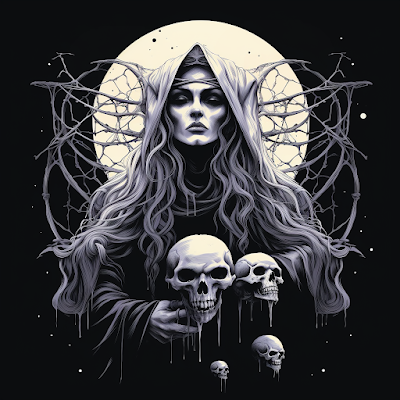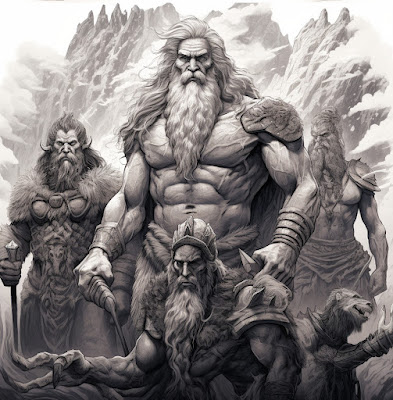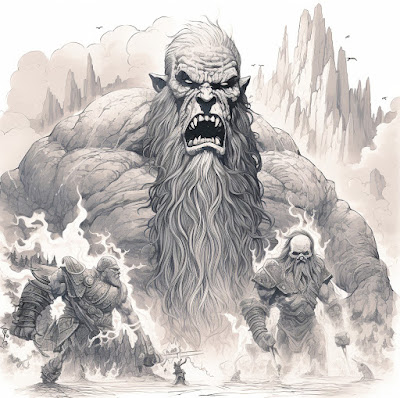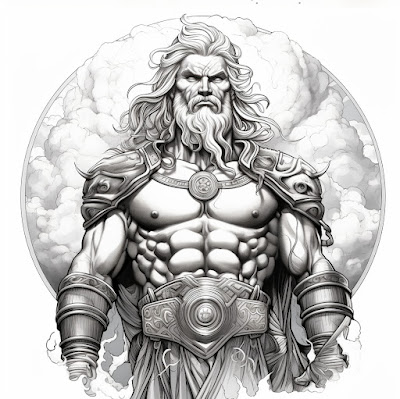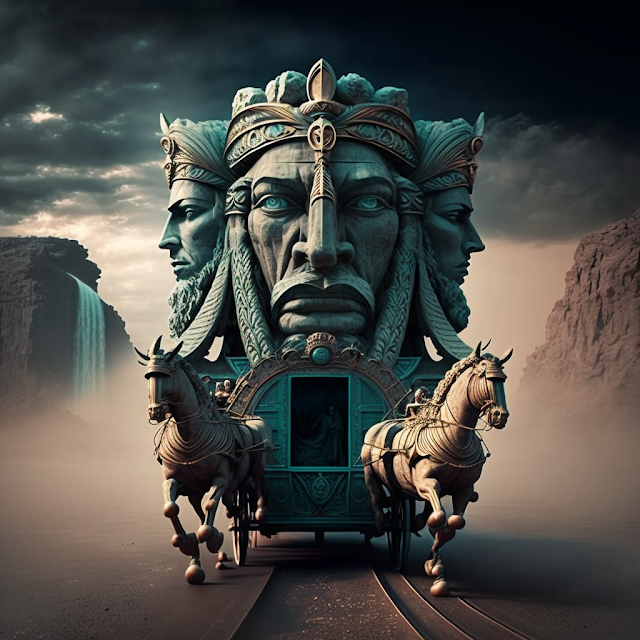This is really a fabulous October. We have five weekends, a full moon near Halloween, a Friday the Thirteenth (today) AND a total Solar Eclipse in some parts of the country tomorrow. In celebration of tomorrow's solar/lunar event, I thought it would be good to discuss my God of the Sun and Goddess of the Moon, as well as other Divine Twins.
The Divine Twins in the Black Forest Mythos
The motif of the Divine Twins is one that comes up again and again in most religions and myths. Usually they are the children of the main sky God, and they serve complimentary functions. Other twins are heroes who have many adventures with the gods.
Jäger and Jägerin
These gods are my syncretized versions of the Roman Apollo and Diana with the Norse Freyr and Freyja. They are the gods of the Sun and Moon respectively. Their names mean "Hunters" to help stress the importance that hunting, more than war, is to these people. They also see these gods as Nature gods, so sometimes they are depicted with stag horns. Curious note. The Norse and Germanic peoples of this time measured time in "Nights" not days. So these combined gods are both the stewards of time.
When needed, Jägerin can don the armor of war and gather Die Kriegerin, the Goddesses of war (much like the Valkyries). They are also the patrons of the arts bringing music and poetry to the people.
When the moon eclipses the sun, it is said that Jägerin has put up her shield to protect her and her brother in battle.
JÄGER (God of the Sun, Music, Hunting)
Intermediate God
ARMOR CLASS: 2
MOVE: 18" / 36"
HIT POINTS: 300
NO. OF ATTACKS: 3
DAMAGE/ATTACK: 2d8/2d8/2d8 + Fire
SPECIAL ATTACKS: Sunbolt
SPECIAL DEFENSES: Firey Aura
MAGIC RESISTANCE: 75%
SIZE: M (6' 2")
ALIGNMENT: Neutral Good
WORSHIPER'S ALIGN: All (mostly Good)
SYMBOL: Sun Disc or Bow
PLANE: Himmel
CLERIC/DRUID: 10th Level Druid
FIGHTER: 20th Level Fighter
MAGIC-USER/ILLUSIONIST: Nil
THIEF/ASSASSIN: Nil
MONK/BARD: Nil
WITCH/WARLOCK: Nil
PSIONIC ABILITY: II
S: 20 I:18 W: 18 D: 20 C: 20 CH:20
Jäger is the god of the Sun but is not the sun. He rides his chariot across the sky, searching for the best game to hunt. His tales of his hunting prowess are matched only by tales of his amorous exploits. He is married to Liebhaberin, but both gods are free to choose other lovers as they see fit. He is the model of youth in his prime.
As the god of the sun he can cast any light, fire, or sun-based spell as a 10th-level spell caster and spells he can cast as a 10th-level Druid. His main weapon is his bow. He can fire three arrows per round each hitting a different target. If he chooses, each (or any) arrow can burst into flame for an additional 1d8 points of damage. Additionally he can fire a Sunbolt for 1d10 points of damage. He can also wreathe himself in the Aura of the Sun. This causes Blindness to any that look at him and 1d8 hp of damage to any with 5' of him every round.
He is often accompanied by a group of deathless hunters. These are men who died while hunting or who wished not to move on to their afterlife after death. They hunt in ghostly processions across the land. Anytime a person sees a falling star, they know a new hunter has joined Jäger's ghostly party. Each acts as 10th level fighter and are similar to spectres.
Additionally, he is the god, or rather patron of, music. When not hunting, he can be found singing or playing an instrument.
Animal: The hunting dog or stag
Rainment: (Head) a solar disc or a crown of antlers (Body) Simple hunting garments
Color(s): Yellow, Gold
Holy Days: Every day at sunrise and noon
Sacrifices: Animal sacrifice at sunset. Animals are then eaten by congregants.
Place of Worship: Any open space.
JÄGERIN (Goddess of the Moon, Poetry, Hunting, War)
Intermediate Goddess
ARMOR CLASS: 2
MOVE: 18" / 36"
HIT POINTS: 300
NO. OF ATTACKS: 3
DAMAGE/ATTACK: 2d8/2d8/2d8 + Chill
SPECIAL ATTACKS: Moonbow
SPECIAL DEFENSES: Aura of Madness
MAGIC RESISTANCE: 75%
SIZE: M (6' 1")
ALIGNMENT: Chaotic Good
WORSHIPER'S ALIGN: All (mostly Good)
SYMBOL: Moon disc or Bow
PLANE: Himmel
CLERIC/DRUID: Nil
FIGHTER: 20th Level Fighter
MAGIC-USER/ILLUSIONIST: Nil
THIEF/ASSASSIN: Nil
MONK/BARD: Nil
WITCH/WARLOCK: 10th Level Witch
PSIONIC ABILITY: II
S: 20 I:18 W: 18 D: 20 C: 20 CH:20
Jägerin is the Goddess of Moon, hunting, poetry, and war. she drives her chariot across the sky as does her brother. On the days of the Solar eclipse she is holding up her shield to protect him. On days of the Lunar eclipse he is providing her protection.
Like her twin brother, Jägerin can attack with a bow. Her arrows do 2d8 and can also add an extra 1d8 hp of chill damage. She can surround herself with an Aura of Madness, any who come within 10' of her will attack anyone else but her. She can cast any spell relating to night or the moon as a caster of the 10th level and as a 10th-level Witch.
Jägerin also has a retinue of hunters with her. These wild women will run through the forest with her in a blood lust for the hunt. They are not dead, but they are no longer alive either. Each acts as a 7th-level fighter and can transform into an animal. Wolves are most common. When needed though, she can call on her Hunt and don the armor of war. These wild women are then known as Die Kriegerin, or the Goddesses of War.
Like her brother, Jägerin is also the patroness of the arts, in this case poetry. She is equally as lascivious as her brother. One tale is told how she boasted she could hunt and kill as many animals as a group of men hunting in the wood. The all agreed to set out in the morning to hunt and return by night fall. Jägerin spent the night having sex with all the hunters and making them too tired to hunt the next day. She was able to go to the wood and hunt at her leisure, easily beating all of them.
Animal: The hunting dog or stag
Rainment: (Head) a moon disc or a crown of antlers (Body) Simple hunting garments
Color(s): Yellow, Gold
Holy Days: Every moonrise
Sacrifices: Animal sacrifice after sunset. Animals are then eaten by congregants.
Place of Worship: Any open space.
Siege and GlückeThese are the Goddesses of Victory and Luck, respectively.
SIEGE and GLÜCKE (Goddess of Victory and Luck)
Lesser Goddess
ARMOR CLASS: 4
MOVE: 18" / 36"
HIT POINTS: 150
NO. OF ATTACKS: 2
DAMAGE/ATTACK: 1d8/1d8
SPECIAL ATTACKS: Change Outcome
SPECIAL DEFENSES: Change Outcome
MAGIC RESISTANCE: 25%
SIZE: M (6' 0" and 5'19)
ALIGNMENT: Lawful Neutral (Siege) and Chaotic Neutral (Glücke)
WORSHIPER'S ALIGN: All
SYMBOL: Spear
PLANE: Himmel
CLERIC/DRUID: Nil
FIGHTER: 10th Level Fighter (Siege)
MAGIC-USER/ILLUSIONIST: Nil
THIEF/ASSASSIN: 10th Level Thief (Glücke)
MONK/BARD: Nil
WITCH/WARLOCK: Nil
PSIONIC ABILITY: II
S: 16 I:18 W: 18 D: 20 C: 18 CH:18
These goddess are not worshipped in the strictest sense, but are called on often enough to grant favors to mortals. Siege is the Goddess of Victory; she represents success through skill and determination. Glücke is the Goddess of Luck; she represents success through luck and happenstance.
Both Goddess can offer a boon to a mortal in the form of gift of Success. Mortal with this gift can re-roll any missed attack, ability check or saving throw and take the better of the two rolls. Most mortal only get this gift once in their lives. Others, such as the hero twins Magni and Muthi, get this boon often.
Magni and MuthiMagni and Muth are the Demigod hero twins of this myth. They are two fun and adventure-loving brothers whose tales are often used to teach moral lessons but also entertain. They typically begin with the brothers getting kicked out of their home because their mother (usually described as a hideously ugly witch but also described as the best cook in the world) is tired of them breaking things. The brothers devise a scheme to either get rich, get drunk, or find some maiden to bed. They often run afoul of some person in power, a barkeep, angry husband, father, and/or brothers. The more they try to solve their problems, the more (comical) trouble they get into. Magni is the Strongest Man alive, and there is nothing he can't lift or break. Muthi is the Bravest Warrior known, and he fears nothing, no man, demon, or god. Their tales will sometimes emphasize how much Magni is afraid of something or how something is too heavy for Muthi.
In the end, the brothers usually come out ahead. They get the money, the ale, and the girls and will be seen headed home, where their mother has made them a fantastic meal. They are mischievous but rarely evil. They only kill monsters and prefer to make fools out of human or divine opponents.
It is said they are deeply in love with Siege and Glücke, but can't make up their minds about who is in love with whom.
The only time the brothers fight each other is when they have their eyes on the same woman. And in these tales, the moral is always the same. While fighting each other, they lose the girl to someone else, and they return home to a scolding by their mother.
MAGNI and MUTHI
Demigods
ARMOR CLASS: 4
MOVE: 12"
HIT POINTS: 110 (Magni), 120 (Muthi)
NO. OF ATTACKS: 3
DAMAGE/ATTACK: 1d10/1d10/1d10
SPECIAL ATTACKS: Nil
SPECIAL DEFENSES: Nil
MAGIC RESISTANCE: Nil
SIZE: M (6' 1" Magni) (5' 11" Muthi)
ALIGNMENT: Chaotic Good
WORSHIPER'S ALIGN: NA
SYMBOL: NA
PLANE: Erde (Earth)
CLERIC/DRUID: Nil
FIGHTER: 18th Level Fighter (Barbarian)
MAGIC-USER/ILLUSIONIST: Nil
THIEF/ASSASSIN: 10th Level Thief
MONK/BARD: Nil
WITCH/WARLOCK: Nil
PSIONIC ABILITY: Nil
S: 25 (Magni) 18 (Muthi) I:10 W: 8 D: 18 C: 20 (Magni) 25 (Muthi) CH: 19
Magni and Muthi are twin brothers. They are not worshipped in the traditional sense but are demi-god heroes of these myths, and their stories are told to children (about how they fight monsters) to adults (how they stop evil people and their sexual exploits).
Magni can add +7 to his to hit and damage rolls due to his strength. Muthi is unaffected by any sort of fear, mundane or magical. This also extends to giving him +3 against any save vs. magic.
Characters encountering Magni and Muthi will often find them "mid-scheme." That is whatever it was they were trying to do has already failed spectacularly, and now they are either running from the authorities or an angry husband/father/brother.
--
Links




